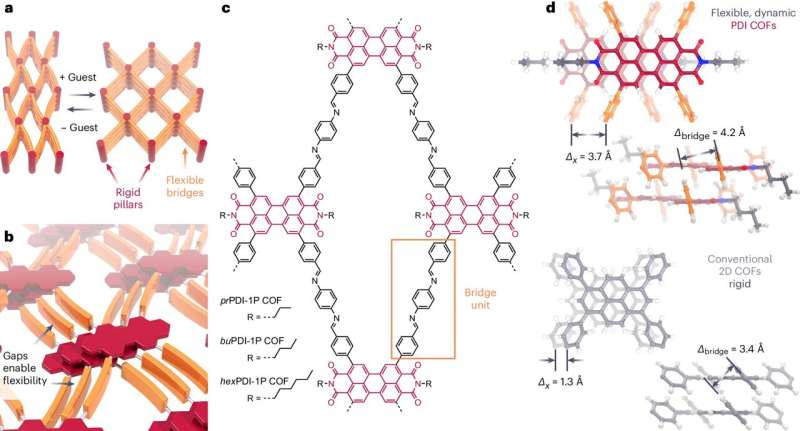a, Illustration of the ‘wine rack’-type dynamic structural transitions. b, The wine rack layout requires a partially flexible framework composed of rigid pillars (shown in red) that are interconnected in two dimensions via flexible bridges (orange). Flexibility is enabled by a substantial lateral offset between COF layers that prevents the bridges from forming close π–π contacts. c, Chemical structure of the dynamic COFs. d, Cutouts of the crystal structures of the buPDI-1P COF (top) and conventional pyrene COFs of similar topology (bottom), illustrating the different packing. In the PDI COF, the butyl substituents and ketones enforce a substantial lateral offset, which translates into a bridge-to-bridge distance of 4.2 Å. As this is substantially larger than typical π–π distances of 3.4–3.6 Å, the bridges are well separated and thus able to bend easily. In contrast, the pyrenes stack with only small lateral offset. This brings the bridge units into close π–π contact, suppressing their flexibility and rendering the COFs rigid. Credit: Nature Chemistry (2024). DOI: 10.1038/s41557-024-01527-8
An international research team led by Dr. Florian Auras from Dresden University of Technology (TUD) has succeeded in developing a new type of material in the rather young research field of covalent organic frameworks. The new two-dimensional polymer is characterized by the fact that its properties can be controlled in a targeted and reversible manner. This has brought the researchers a step closer to the goal of realizing switchable quantum states.
These results were recently published in Nature Chemistry.
Porous covalent organic frameworks (COFs) are a class of highly ordered, porous materials consisting of organic molecules that are linked by covalent bonds to form a network. They enable the construction of functional materials with molecular precision. Similar to metal organic frameworks (MOFs), which were discovered around 25 years ago and have already reached market maturity, COFs possess highly promising structural, optical and electronic properties for numerous applications; for example, in gas and liquid storage, catalysis, sensor technology and energy applications.
Previous research on COFs has generally focused on the construction of rigid frameworks with static material properties. Dr. Florian Auras and his team at the Chair of Molecular Functional Materials at TUD have now developed a design strategy for dynamic two-dimensional COFs that can open and close their pores in a controlled manner, similar to a sponge.
"The main aim of the study was to equip these frameworks, which are normally very precisely ordered but rigid, with exactly the right degree of flexibility so that their structure can be switched from compact to porous. By adding solvent to the molecular sponge, we can now temporarily and reversibly change the local geometry as well as optical properties such as color or fluorescence," says Dr. Auras.
The ability to switch the structural and optoelectronic properties of the materials back and forth in a targeted manner makes the materials particularly interesting for future applications in electronics and information technology.
"Our research results form the basis for our further research into stimuli-responsive polymers, particularly with the aim of realizing switchable quantum states. When working on COFs, I am always fascinated by how precisely their properties can be manipulated by controlling the molecular structure," adds Dr. Auras.
More information: Florian Auras et al, Dynamic two-dimensional covalent organic frameworks, Nature Chemistry (2024). DOI: 10.1038/s41557-024-01527-8
Journal information: Nature Chemistry
Provided by Dresden University of Technology
























